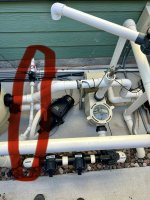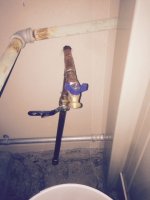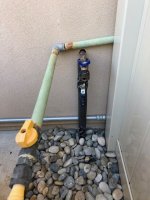Hi,
I have a leak in my pool which was built without an autofill. I have been using a hose and a 'toilet' style top off mechanism for the last decade. We did some work on our pool this winter and hopefully i have less leaking.
The pool sits in the sun all day so evaporation is an issue.
I am looking to use either an orbit (water sprinkler Amazon.com ) wifi system to turn on & off the water which is being injected into the pool plumbing.
We will tap into one of the lines in the plumbing. Have a hose bib plugged into the water sprinkler device - or we may use a powered solenoid (example only - Amazon.com) with a lutron device powering it on & off.
1. Hose bib (water supply)
to
2. Orbit or Solenoid to PVC (Amazon.com or Amazon.com
to
3, PVC Check valve (any recommendations on something that can handle salt but is close to hose bib size?)
to
4. tapped into pool plumbing.
I am planning on running it an hour a day to see how the water level holds up.
Any suggestions or list of parts? Maybe someone sells something already?
Thanks,
Rich
I have a leak in my pool which was built without an autofill. I have been using a hose and a 'toilet' style top off mechanism for the last decade. We did some work on our pool this winter and hopefully i have less leaking.
The pool sits in the sun all day so evaporation is an issue.
I am looking to use either an orbit (water sprinkler Amazon.com ) wifi system to turn on & off the water which is being injected into the pool plumbing.
We will tap into one of the lines in the plumbing. Have a hose bib plugged into the water sprinkler device - or we may use a powered solenoid (example only - Amazon.com) with a lutron device powering it on & off.
1. Hose bib (water supply)
to
2. Orbit or Solenoid to PVC (Amazon.com or Amazon.com
to
3, PVC Check valve (any recommendations on something that can handle salt but is close to hose bib size?)
to
4. tapped into pool plumbing.
I am planning on running it an hour a day to see how the water level holds up.
Any suggestions or list of parts? Maybe someone sells something already?
Thanks,
Rich





